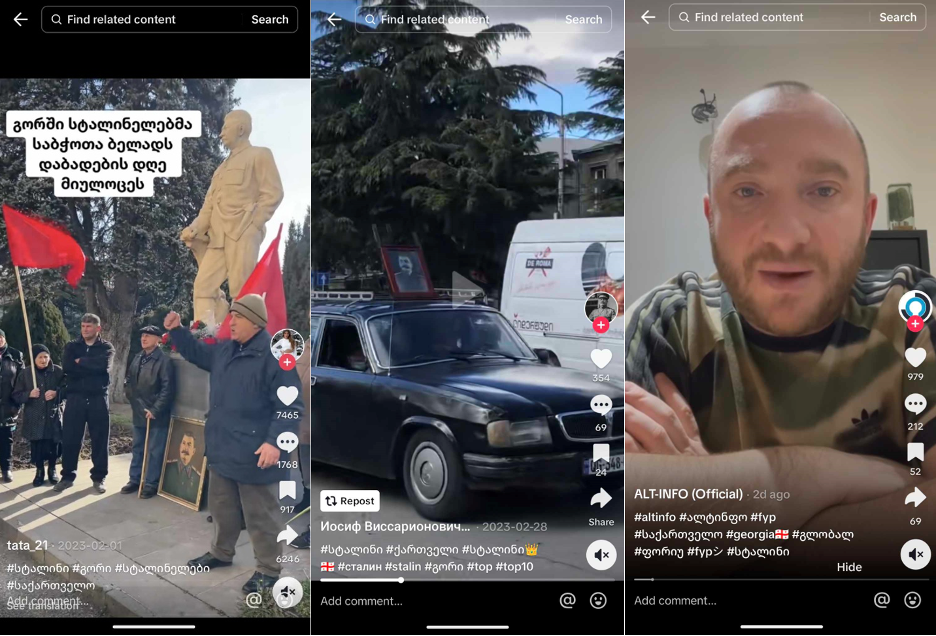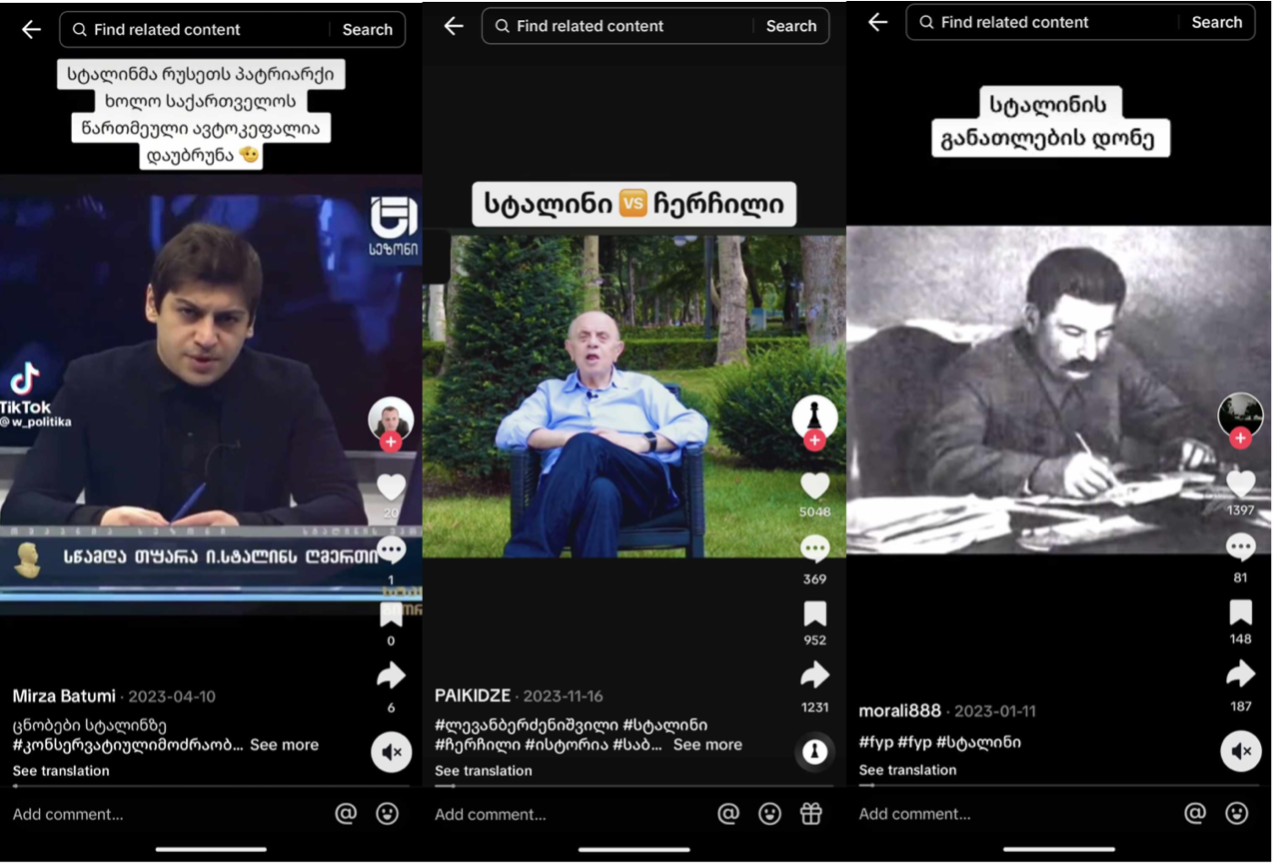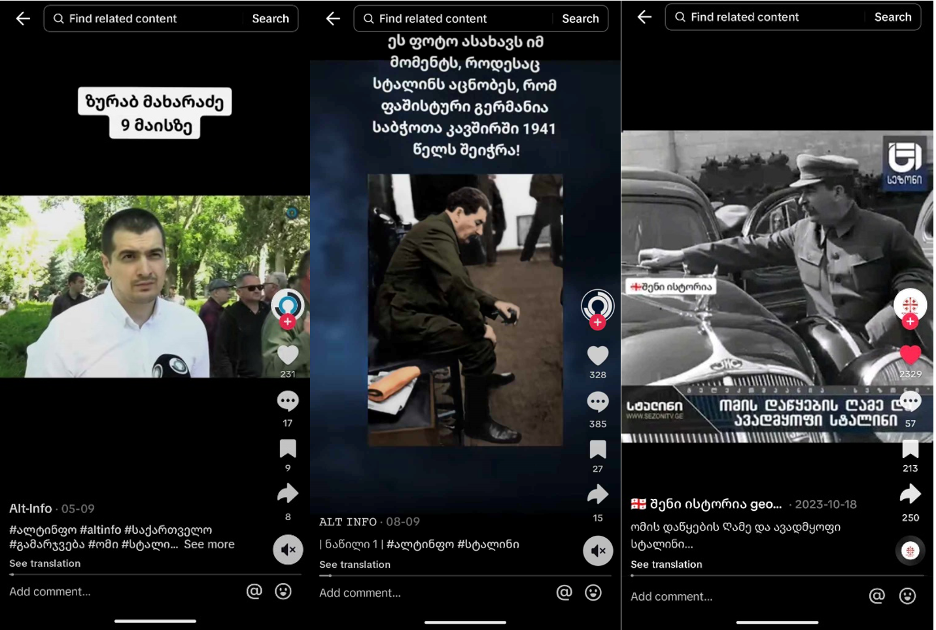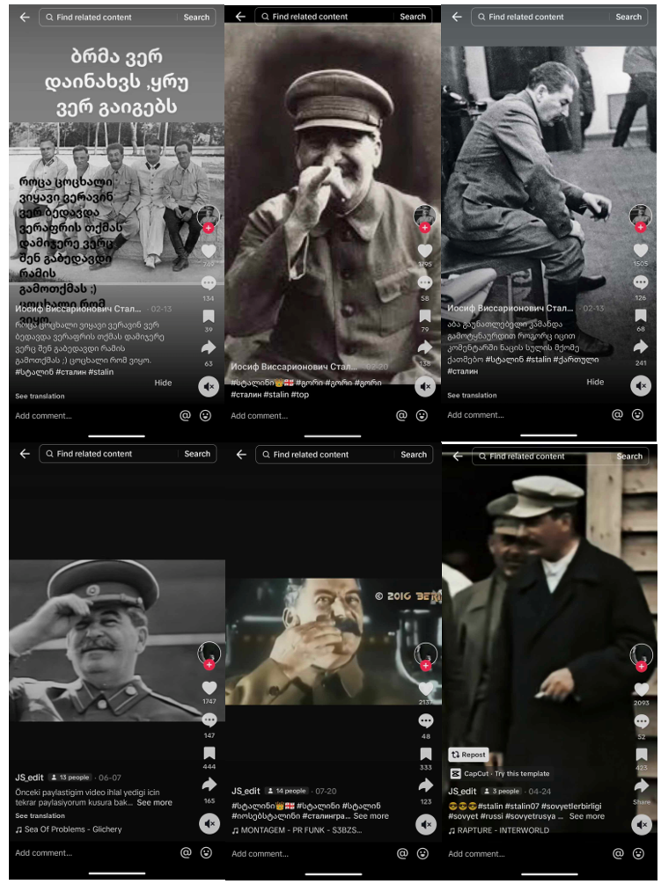Stalin lionized on Georgian TikTok
TikTok videos promote myths about late Soviet dictator Joseph Stalin, portraying him as a religious, well-educated strongman
Stalin lionized on Georgian TikTok

BANNER: A woman holds a phone with a portrait of Soviet leader Joseph Stalin during an event marking the 70th anniversary of Stalin’s death in his hometown of Gori, Georgia, March 5, 2023. (Source: Reuters/Irakli Gedenidze)
A majority of Georgian TikTok videos referencing Joseph Stalin portray the late Soviet dictator as a heroic and decisive leader, according to an investigation by the DFRLab. In the wake of recent public discussions around Stalin in Georgia alongside TikTok gaining popularity among young people in the country, political actors are aligning their political messages with the platform’s dynamics, promoting historical revisionism and myths about Stalin’s personality.
Stalin, who ruled the Soviet Union from 1924 to 1953, was responsible for the deaths and deportation of millions of people. His hometown of Gori, Georgia, approximately fifty-five miles from the country’s capital Tbilisi, plays a significant role in romanticizing his figure and evoking Soviet nostalgia among Georgians. Despite a wide majority of the population supporting Georgia’s Euro-Atlantic integration, a sizable segment also believes that Georgians should take pride in Stalin.
Russian propaganda has consistently instrumentalized Stalin, using his image to evoke Soviet nostalgia and strengthen Russian influence in Georgia. According to the Media Development Foundation, a local disinformation research organization, the glorification of the Soviet past, particularly the idealization of authoritarian governance and justification of Stalin’s crimes, are tactics employed in pro-Kremlin disinformation campaigns in Georgia. In an interview with Civil.ge, historian Irakli Khvadagiani argued that Russian propaganda attempts to incorporate Stalin into Georgian nationalism to foster a “nativist anti-western strain.”
A 2021 CRRC poll suggested that 30 percent of young people in Georgia (18-34 age group) agreed with the statement that a Georgian patriot should be proud that Stalin was Georgian, while an additional 64 percent of the same age group agreed with the statement, “It’s hard to assess the legacy of Stalin; there were pluses and minuses to his rule.” Many Georgians continue hold positive sentiment toward the Soviet period in Georgia’s history.
The Georgian Orthodox Church (GOC) plays a significant role in promoting Stalinism in Georgia. In a 2013 interview with RT, church Patriarch Ilia II expressed admiration for Stalin, stating, “Stalin was an outstanding person. Such people are quite rare. He understood the worldwide significance of Russia.” In 2021, Archbishop Spiridon Abuladze claimed that Stalin was a religious person who prayed extensively.
More recently in January 2024, the discovery of an icon in Tbilisi Holy Trinity Cathedral depicting St. Matrona of Moscow offering a blessing to Stalin triggered a public outcry, alongside a resurgence of myths suggesting that he was secretly religious. In one such myth, Stalin allegedly met with St. Matrona in 1941 before the Soviet Union entered World War II and followed her advice by flying a holy icon on a plane over Moscow to protect the city from Hitler. Stalin’s meeting with the saint, however, is considered a legend, as it is not confirmed in historical sources. Kremlin propaganda deliberately promotes the general image of Stalin as a religious figure as a means of tailoring its messaging to religious Georgians.
Stalin, despite receiving education to become a priest, was an atheist. When he came to power, he sought to enforce atheism in the Soviet Union. Stalin perceived the faith and religious practices of peasants as significant obstacles to establishing the new “socialist man.” To achieve forced secularization, Stalin established the League of Militant Godless, which played a key role in adopting and implementing anti-religious five-year plans. These Soviet-era campaigns prohibited exercising religious practices and targeted clergy, who became victims of purges and repression. During its decades in power, the Soviet regime produced anti-religious posters, one of the more infamous of which depicted an astronaut in space with the caption “There is no god.”
The controversy surrounding the icon escalated further when civil activist Nata Peradze threw blue paint on it. In response, the violent pro-Kremlin group Alt-Info and its affiliated political party, the Conservative Movement, mobilized supporters to march on Peradze’s house. Alt-Info’s online channels, along with GOC priests, exploited the incident to incite anti-Western sentiment and accuse “liberals” of fighting against Georgian traditions and religion. Giorgi Kandelaki, a former member of parliament and historian at SovLab who initially disseminated the video of the icon, stated that the depiction of Stalin was a “new success of Russian information warfare” in Georgia.
Stalin on TikTok
The DFRLab identified the three most frequently used hashtags for TikTok videos about Stalin. Videos tagged with the hashtag #სტალინი (“Stalin”), the most popular of the three, had garnered roughly 11.6 million views as of January 11, 2024. This was followed by #სტალინი👑🇬🇪 (“Stalin 👑🇬🇪”), which achieved approximately 3.9 million views, and, #იოსებსტალინი (“Joseph Stalin”), which had around 813,700 views.
The DFRLab scraped and analyzed 237 videos using the hashtag #სტალინი (“Stalin”) published on or before January 11, 2024, and eliminated 93 false positive videos, which included random videos which did not include suspicious narratives about Stalin. False positives also included those videos that solely used the hashtag, but the content appeared unrelated to Stalin. We also removed videos depicting Grisha Oniani, a notorious Stalinist and owner of Stalin’s private museum who is also often satirized because of his views. Out of the remaining 144 videos, we could not categorize fifteen videos published by the channel @soviet.union754 as they were unavailable at the time of analysis. After identifying the top contributing channels, we manually collected additional videos on TikTok about Stalin that did not use the hashtag. Ultimately, we ended up with 150 videos and grouped them into six categories based on their content.
Most videos consisted of compilations featuring pictures or historical footage of Stalin accompanied by macho or heroic music, in an attempt to instill the impression that he was a strong and decisive leader. This style is characteristic of Georgian TikTok, with significant emphasis on background music. The second most frequent category comprised videos presenting educational, historical content about Stalin. This was followed by videos perpetuating myths about Stalin’s personality, claiming he was religious and well-educated. After those two were videos disseminating historical myths about Stalin and his leadership, videos featuring Stalin quotes, and others showcasing monuments or portraits of Stalin across different regions of Georgia.
In terms of viewership, TikTok videos depicting monuments to Stalin garnered the highest number of views, followed by educational content, myths about his personality, and quotes attributed to Stalin.
The DFRLab analyzed videos that promoted Stalin in a positive way or contained myths and historical revisionism narratives. The most popular video category on TikTok was monuments and portraits of Stalin in Georgian regions, which garnered more than one million views on the platform. According to the Soviet Past Research Laboratory (SovLab), twelve new Stalin monuments have been erected in Georgia since 2012, despite the display of Soviet symbols being banned in the country. The channel @tatia_goloshvili_21 published the most popular video in this category, which showed pro-Stalinist individuals celebrating the late dictator’s birthday by erecting a monument alongside a Soviet flag in the town of Gori. As of March 14, 2024, the video had amassed more than 360,000 views. In another video from @altinfo2, Konstantine Morgoshia, leader of Alt-Info and the Conservative Movement, claimed that the majority of Gori’s population supported the idea of erecting a monument in the town.

The second most popular category repeated three myths about Stalin’s personality, including that Stalin was deeply educated man and read 20,000 books, as evidenced by his notes in these books; that Stalin was fond of Georgian culture and literature; and that Stalin was a religious person. Videos in this category were viewed more than 940,000 times. All three myths are discussed by historians in a publication titled “13 Myths about Stalin,” which aims to refute these myths and shift the narrative about Stalin’s character in Georgia.
For example, the publication declares that there is no evidence that Stalin read as many as twenty thousand books; the annotated collection of Stalin’s library, as documented, consists of 391 books. Additionally, there are multiple historical sources claiming that Stalin did not have any distinguished attitude or sentiments toward Georgia; on the contrary, he is perceived as an important figure in strengthening Russian nationalism. Lastly, the myth that Stalin was religious person has been debunked on multiple occasions. Soviet anti-religion propaganda is well-documented in history. Stalin’s repressions targeted clergy, and hundreds of churches in Georgia were either demolished or utilized for other purposes under his rule.

We identified nineteen videos with the hashtag #სტალინი (#Stalin) that promoted historical myths about Stalin and the Soviet Union. The majority of the videos accompanied by this hashtag focused on Stalin’s role in defeating Nazi Germany. For instance, Alt-Info’s TikTok account posted interviews with its leaders, Zurab Makharadze and Irakli Martinenko, during Victory Day celebrations on May 9, 2023. In the video, Makharadze stated that Stalin is as great a historical figure for Georgians as Napoleon is for Corsicans and that the victory over the Nazis in World War II is associated with Stalin. Martinenko conveyed a similar message, asserting that the world owes a debt to Georgians for their role in World War II and that to forget this is not only a crime but a direct betrayal of state interests.
Promoting myths about World War II is a common Kremlin tactic, serving the purpose of legitimizing current Russian President Vladimir Putin’s actions in Ukraine and his broader foreign policy agenda. This is evident in an article written by Putin for the 75th anniversary of World War II in 2020, in which he attempted to dismiss and deflect the existence of the 1939 Molotov-Ribbentrop Pact that divided Eastern Europe and set up cooperation between Nazi leader Adolf Hitler and Stalin. History contradicts Putin’s current agenda, yet promoting Stalin and the Soviet Union as the major force that defeated Nazi Germany and controlling how the collective memory of World War II is framed in Russia is crucial for the country’s modern narrative.

Another category featured compilations of footage of Stalin accompanied by macho or heroic music. Three channels were most active in this category: Georgian channel @stalinnnn, with more than 3,000 followers and 26,400 total likes at the time of publishing; Turkish channel @JS_edit1, with more than 2,100 followers and 31,700 likes; and a channel of unknown origin, @soviet.union754, with just over 1,000 followers and more than 2,800 likes. The last channel seems to have deleted all of its videos that used the Georgian-language “Stalin” hashtag and started uploading new videos, resulting in a low number of views.
Some analyzed videos from this category were watched tens of thousands of times. For instance, a video posted by @stalinnnn, with the caption “When I was alive, nobody dared to say anything, believe me, you wouldn’t dare to say anything either 😉 If I were alive” in Georgian (presented as if it were Stalin’s quote), had garnered more than 72,000 views at the time of publishing.

We also identified fourteen videos featuring quotes attributed to Stalin. The videos in this category accumulated more than 750,000 views. The most-viewed one was published by the channel @avtandilbekauri and garnered more than 230,000 views. The video depicted eight quotes supposedly attributed to Stalin. Another video by the TikTok channel @stalinnnnn used a supposed Stalin quote, “I do not trade field marshals for lieutenants,” and was viewed more than 85,000 times.
As TikTok gains popularity in Georgia, pro-Kremlin and anti-Western actors are attempting to migrate to the platform to target TikTok users with their agenda in an effort to shape public opinion in the long term, given the generally younger demographic on the platform. Similarly, Georgian TikTok serves as a platform where Stalin is romanticized, further contributing to the cult of personality surrounding him. Most videos on the platform promote a heroic and decisive image of Stalin, often intertwining historical revisionism and perpetuating myths about his personality. The narratives disseminated on TikTok frequently align with broader historical revisionism orchestrated by pro-Kremlin actors, seeking to legitimize Russian foreign policy goals and downplay the totalitarian rule of Stalin.
Cite this case study:
Sopo Gelava, “Stalin lionized on Georgian TikTok,” Digital Forensic Research Lab (DFRLab), March 14, 2024, https://dfrlab.org/2024/03/14/stalin-lionized-on-georgian-tiktok.

